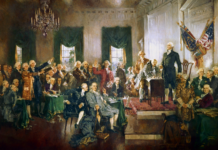A story was released yesterday, from Leesburg, Virginia, highlighting a fifth-grade teacher who had quit her job in tears because she refused to teach her children Critical Race Theory. This is becoming more common as the ideological indoctrination methods of the left are being firmly implanted in all our educational systems. If you are familiar with my story, I was told by a professor in a university social work program that my opposition to the white privilege concept made me unfit for the field. I also listened to a woman on the Rush Limbaugh show describe a similar experience, as she was told she could not complete her teaching degree if she didn’t acquiesce to the idea that white people had unearned privileges in society, and that we perpetuate a system of white supremacy. The bigger problem is the elementary school in question isn’t really teaching Critical Race Theory as much as they are an anti-racism curriculum meant to change the way students view race. It is important to understand the difference if Critical Race Theory is going to be challenged in any way. While teaching school children race-based lessons meant to make white people look racist can be banned, that doesn’t stop the use of CRT as a research model, used to examine the policies of the school system itself, to identify systemic racism. In other words, you can stop teachers from teaching these lessons, but the CRT scholars are still there, submitting papers that show the racism they claim, is endemic in the system. Papers, mind you, that lawmakers consider when formulating social policy.
What is the difference then? Why isn’t teaching race-based lessons, meant to shame the white man necessarily Critical Race Theory? It certainly isn’t an easy concept to understand without a serious study into the topic of CRT and all of its tenets. For example, a paper entitled Will the Real CRT Please Stand Up? The Danger of Philosophical Contributions to CRT discusses the difference between Critical Race Theory and what the author calls, Critical Theories on Race. The latter denotes the idea that racism can be solved by eliminating attitudes, words, and other superficialities that contribute to something called racial idealism. This is the belief that racism itself, is an individual problem. Something that lies in the heart of people, and not a problem inherent in the normal, everyday manner the system operates. Looking at the anti-racism lessons taught in elementary school, it could be argued that they are meant to eradicate racist attitudes by inducing feelings of guilt in white children. This is something discussed in greater detail in my book, A Critical Look at CRT in Education, Research, and Social Policy. These lessons are nothing short of political conditioning, meant to create feelings of shame towards Americanism. However, according to the author of Will the Real CRT Please Stand Up, these lessons fall short of being CRT because they focus on racism as an individual, not a systemic problem, and because of this, “they are impotent to challenge racism in its social, political and systemic manifestations” (Curry, 2009).
Curry (2009) suggests that there is a definite relationship between Critical Theories of Race and CRT, however, the former focuses more on developing an understanding of race from a theoretical perspective. Critical Race Theory, on the other hand, “acknowledges the need for radical political and legal activism against whites and whiteness” (Curry, 2009). It is being argued by Curry (2009) that CRT was co-opted by a philosophical movement that believed white people could be conditioned to self-reflect on their own racist attitudes, and by integrating Critical philosophies of race into the white consciousness, racism could be solved. White liberals who are attaching the label of CRT to their work, are still dominating the racial discourse, and by defining the terms in which race and racism are understood, are still contributing to the white supremacist system. The real Critical Race Theory is a challenge to the very ideals of western civilization without apology. Curry (2009) argues that CRT scholars are not interested in philosophical contributions which attempt to re-socialize white people into acknowledging their privilege, but deconstructing the very idea of “whiteness,” which is protected in American law. Critical Race Theory does not attempt to create a peaceful, multicultural world. Rather, its foundations are built on the belief that racism is a normal, everyday part of American society, and the ideals put forth in the civil rights movement have failed. CRT rejects the notion that racism can be solved by focusing on racial ignorance. Instead, the scholarship driving CRT is based on the idea that Black and White people cannot peacefully coexist, and a “constructive engagement with whites” will accomplish nothing because we are operating from the perspective of maintaining our own dominance.
Just as I have mentioned in my book, understanding Critical Race Theory requires a thorough understanding of its parent philosophy, Critical Theory. Racial consciousness was brought into the realm of “critical thought” when a man named Lucius Outlaw looked to the Critical Theory of the Frankfurt School of Social Research to determine if the approach taken to understand social and economic inequalities, could be applied to the twentieth century understanding of race as a science (Curry, 2009). To truly understand the differences between Critical Theories of Race, and Critical Race Theory requires an understanding of Critical Theory itself. It was Outlaw’s investigation into Critical Theory that brought racial issues to the forefront of philosophical thought. It was Outlaw’s contribution that paved the way for a “Critical” approach to racial issues, creating the possibility for a social justice agenda. Furthermore, Curry (2009) also suggests that it was Outlaw’s “critical” approach that allowed for race to move away from a fixed, biological definition, and to something that can be described through lived experiences and assigned social meanings. In other words, the notion that Black identity is defined in terms of oppression and marginalization can be attributed to the application of Critical Theory to racial issues.
Critical Race Theory continues to gain the attention of the American people as there is undoubtedly, an effort to indoctrinate our children into racial identity politics. It is imperative to understand the differences between lessons meant to create a new racial consciousness and the research being done under the tenets of Critical Race Theory. Critical Theories of Race do little more than define racism as an individual problem, with the main objective of eliminating the superficialities which make up what is called racial idealism. The real CRT scholars are hard-core Marxists, working to dismantle western culture. They reject the notions of racial idealism on the grounds that racism is endemic in the American ethos, and that the system itself, works to maintain its own supremacy. They reject the notion that white people can be re-socialized to be less racist because the alleged privileges we enjoy, are tied to the white supremacist system which keeps minorities down. Critical Race Theory goes as far as rejecting the normative views of equality under the law in favor of policies that promise equality of outcome.
To learn more about CRT check out my latest book. Now available in paperback.


























